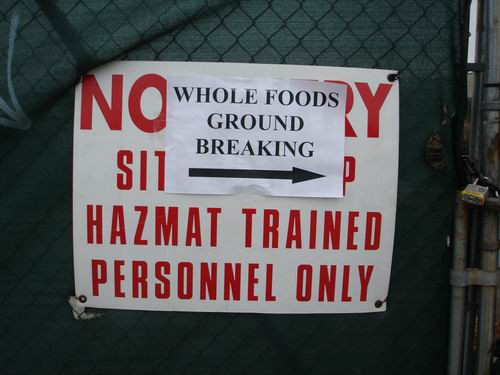Toxic Brooklyn: Are Current Clean Up Methods Safe?
 The toxic cleanup strategy of choice for polluted sites in New York and elsewhere is "capping," a method whereby some toxic soil is removed and the remainder of the problem is sealed beneath a membrane. It is the way the Public Place site in Gowanus (which is profoundly contaminated) would be cleaned and the way Whole Foods says it will make its toxic Gowanus site clean. It is also the method being used at the Roebling Oil Field (AKA McCarren Park Mews) in Williamsburg. But, is it safe?
The toxic cleanup strategy of choice for polluted sites in New York and elsewhere is "capping," a method whereby some toxic soil is removed and the remainder of the problem is sealed beneath a membrane. It is the way the Public Place site in Gowanus (which is profoundly contaminated) would be cleaned and the way Whole Foods says it will make its toxic Gowanus site clean. It is also the method being used at the Roebling Oil Field (AKA McCarren Park Mews) in Williamsburg. But, is it safe?Environmentalists have long said that capping is cheaper than a full cleanup, but not terribly safe. In New York, where state-supervised cleanups done by developers were in vogue during the Pataki years, there's been little controversy. In New Jersey, though, the method is raising questions. There are even proposals to ban or severely restrict the cleanup method, which raises some very interesting--if not deeply troubling--questions about living, working and recreating above capped sites.
We turn to an article in The Record--which actually appeared a week ago--but is very, very interesting in the context of Brooklyn and of New York City where so-called brownfields are targeted for heavy development in coming decades. If you read one article this week, this story should be required reading. Here's a sample:
In North Jersey, this is the new definition of clean: Thousands of people living, working and playing on properties where pollution has been "capped" -- buried under pavement or dirt rather than removed.There's a long discussion about whether the caps are safe or not, and a lot of people think they are not. Read this article.
As many as 540 sites statewide have been capped. More are on the drawing board ready to sprout million-dollar town houses, senior citizen complexes, strip malls and office buildings.
Developers love caps because they save millions when they don't have to dig up contamination and haul it away.
But caps also raise sticky questions: Is life atop a toxic tomb safe? Could chemical vapors seep out of the ground? Who'll make sure no one sticks a shovel in the wrong spot, unleashing poisons through the simple act of planting a tree?
And if they did, who would know? New Jersey has one inspector -- the "cap cop" -- to check these sites. Environmentalists have long maligned caps as "pave and wave" for what they say is the shoddy quality of the cleanups. Now, state officials are also concerned.
"Many would argue that ... the quality of the remediation is poor," the state's environmental commissioner, Lisa Jackson, told a committee of state legislators last fall, "and that developers pursue the cheapest solutions in order to quickly get a profit."
[Photo courtesy of Random Brooklyn]

0 Comments:
Post a Comment
<< Home